

|
|
"Katzenjammer Kids" is a registered trademark of The Hearst Corporation and is used by permission. |
|
Welcome to fans of the fabulous Katzenjammer Kids. 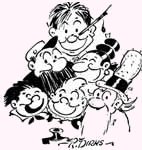
In the event that you are not familiar with the Katzies, they were the central characters in what is regarded by many as the first true color comic strip. The Katzenjammer Kids first appeared in the Sunday comic pages in December 1897, which means that Hans and Fritz are now engaged in their second century of antics in the funny pages. The picture above is a self-portrait drawn by Rudolph Dirks, the creator of the Katzenjammer Kids. The main characters in the comic strip were Mamma Katzenjammer, her twin sons, Hans and Fritz, and the long-suffering target of their mischief, The Captain. The Katzenjammer Kids is an "ethnic" comic strip. All of the characters speak with a German accent. "Just" becomes "chust," "we" becomes "ve," and the Captain is, of course, "der Captain." This device provided part of the charm of the strip in the early days, though it may be regarded as politically incorrect today. In the early decades of the strip's existence, the Katzenjammer family engaged in adventures all over the world. Ultimately, they settled on a tropical island. But, wherever they were, the continuing and repeated theme centered around the ability of Hans and Fritz to pull creative pranks, get into trouble as a result, and end up being hunted down or spanked over someone's knee in the last panel. 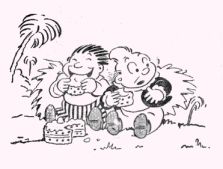
My primary interest is in the version of these characters as drawn by Harold H. Knerr. You can learn more about Knerr and maybe even help me to do the same by checking out his separate page. You'll also find lots more Katzenjammer Kids info, including access to images of two complete Sunday color comic strips. Very little detail about these famous characters is to be found on the World Wide Web. The remainder of this page will serve as a modest attempt to remedy that situation. ORIGIN OF THE KATZENJAMMER KIDS 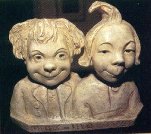
The Katzenjammer Kids are based on "Max und Moritz," similarly mischievous young boys created by artist Wilhelm Busch in Germany. Max und Moritz had been popular in their homeland for more than 30 years before the Americanized version first appeared in William Randolph Hearst's New York Journal Sunday supplement. While touring Europe as a boy Hearst became familiar with the adventures of Max und Moritz. Many years later, as an ambitious newspaper publisher, he was instrumental in the creation and popularization of their American counterparts. Travelers to Germany should certainly make a point of stopping by the Wilhelm Busch Museum in Hanover. Among other items of interest, including original art, the careful observer will have an opportunity to pay tribute to the "grandfather" of the Katzenjammer Kids at the little bust of Max und Moritz shown here. While the above is the generally accepted version of how the Katzenjammer Kids came to be, there is reason to believe that other influences may have played a role. 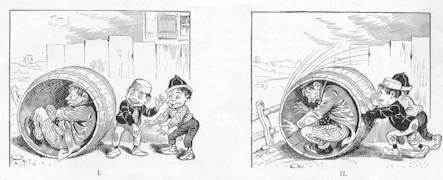 These two panels by F.M. Howarth from a 1895 humor magazine, published two years before the first appearance of the Katzenjammer Kids, is but one example of many earlier illustrations that depict two young boys getting into mischief. For whatever reason, this was a very popular recurring theme of the period. THE EARLY YEARS 
In the early years, the drawings by Dirks were somewhat crude, as is evidenced by this panel from 1901. Even the word balloon had not yet evolved to its present day form. The Katzenjammer Kids first appeared in the Sunday comics section of newspapers on December 12, 1897. It is a little known fact that "Der Captain" was not a member of the cast for the first five years. He first appeared on August 31, 1902. Nor was he ever married to Mrs. Katzenjammer. Rather, the old sea dog was a boarder or, if you will, a live-in companion. The other major cast member, "Der Inspector," first appeared on January 15, 1905. He was not an inspector in the ordinary sense of the word, but, rather, an officer of the school system. A more extended overview of the early history of the strip may be found in my article in "The Encyclopedia of American Comics" by Ron Goulart (Facts On File, 1990). For even more, I recommend the chapter on Rudolph Dirks in Richard Marschall's excellent "America's Great Comic-Strip Artists" (Abbeville Press, 1989). THE LAWSUIT The short version is this: After drawing a weekly Katzenjammer Kids page for 15 years or so, Rudolph Dirks wanted to take a break, something like Garry Trudeau and others have done in recent times. His boss at the Hearst newspaper syndicate didn't see it that way. Dirks left anyway and his duties were assigned to other artists. 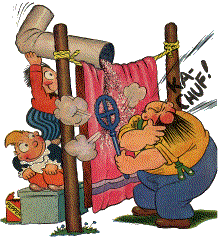
Dirks felt that he owned the rights to his characters and a lawsuit followed. The popular strip dropped out of the Sunday funnies for more than a year. Ultimately, the Katzenjammer Kids were continued for the Hearst papers by Harold H. Knerr, and the court awarded Dirks the right to continue drawing his characters, so long as they were not entitled "The Katzenjammer Kids." This, he proceeded to do for the rival Pulitzer newspapers. The end result was that two separate, but very similar strips ("The Original Katzenjammer Kids" and "The Captain and the Kids") ran in competing Sunday papers for more than half a century. Think how unusual this was! Imagine that "Peanuts" by some other artist was running in one paper, while "Good Old Charlie Brown," by Charles Schulz, was running in another. Oddly enough, many readers who purchased only one Sunday paper probably did not even realize that there was more than one version. 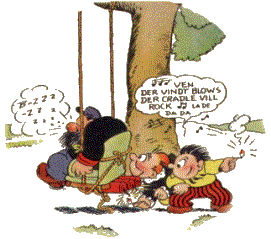 THE CAPTAIN AND THE KIDS
THE CAPTAIN AND THE KIDSThe separate strip by Dirks carried no masthead title at first, becoming "Hans und Fritz" in May 1915. With the entry of the United States into the first World War, things German fell into disfavor and the strip changed names once again, becoming "The Captain and the Kids" in the Summer of 1918. While some may regard The Captain and the Kids as an alternate version of the Katzenjammer Kids, just the reverse would be a more accurate statement. The Captain and the Kids relates the further adventures of the Captain, Hans, Fritz, Mamma, and Der Inspector as envisioned by their creator and rendered by his hand. The "original" version, continued by H.H. Knerr, provides another man's idea of what these characters' adventures might be. In the 1920's, Dirks' troops sojourned on "Cannibal Island," while over in the Hearst camp, Knerr had the Katzenjammers in the "Squee-Jee Islands." Both families had their adventures with the local black royalty. Long John Silver and his band of pirates popped up from time to time in both versions as well. How similar were the two strips? Well, who can look at these two panels and tell which is which? The one on the left is from a 1918 "Captain and the Kids" by Dirks. The one on the right is from a 1924 "Katzenjammer Kids" by Knerr.  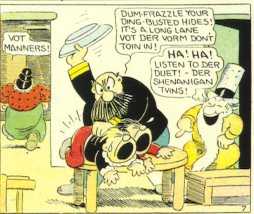 Dirks rendered his characters in a looser style. He was less consistent than Knerr and, on those occasions when he was hurried or gave way to another hand, "The Captain and the Kids" was clearly the inferior of the two strips. At its best, however, the freer style of the Dirks' drawings has a charm that is simply irresistible. In the mid-1940s, when the "one-third" strip size became more of a standard and Knerr's creativity began to slip, it can certainly be argued that "The Captain and the Kids" was the better of the two. That the "Captain and the Kids" and the "Katzenjammer Kids" ran simultaneously for over 50 years is ample testament to the longevity of these characters. In the modern age of instant gratification, when popular icons are at the mercy of a whimsical public, it is safe to predict that no cast of characters will ever match the enduring popularity of the Captain and his company in the hearts of the American public. THE LATER YEARS Following the death of Harold Knerr in 1949, the advent of network television combined with other factors to eclipse the "funnies" as a primary source of escapist entertainment. The space allotted to the individual titles began to shrink and the artists were no longer able to indulge themselves as Dirks and Knerr had done. It may also be fairly said that the artists who succeeded Knerr did not have the personal passion for the strip that he had developed over so many years. Still, a succession of men has carried the torch for nearly as long as Dirks and Knerr did. So they are certainly worthy of recognition. A brief look at their work may be found on a separate page. THE KATZENJAMMER KIDS TODAY After more than 100 years on the Sunday comic pages, the Katzenjammer Kids are still appearing today, although in a relatively small number of papers around the world. Their adventures are now being drawn by Hy Eisman, who is also continuing the adventures of that old sea dog "Popeye." You may find an example of his work at King Features Syndicate's own Katzenjammer Kids Web Page. 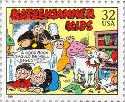
The renowned, and oft maligned, U.S. Postal Service has extended its official recognition, as the Katzenjammer Kids was among those comic strips for which a special stamp was issued in October 1995. You may click the stamp to see a large image of both the original and rough draft artwork for the design. THE ANIMATED FILMSThere were a number of black and white Katzenjammer Kids cartoons made in the silent films era. One of them, entitled "Policy and Pie," may be found on video tape in Volume 3 of "Origins of American Animation," a series produced by the Library of Congress and the Smithsonian. 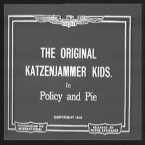
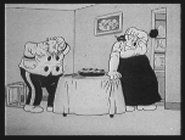 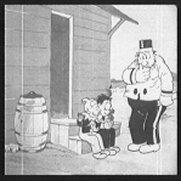 The film was released in 1918 at the height of popularity of these characters. The plot involves an insurance policy bought by the Captain. 
Oddly enough, there do not seem to have been any "Katzenjammer Kids" animated films during the sound and color era. MGM did, however, produce a series of cartoons based on the Dirks version of the characters: "The Captain and the Kids." A poster for one of them is seen here. In 1938 and 1939, more than a dozen such films were released. Some of these turn up on the "Cartoon Network" cable channel from time to time. The directors included Friz Freleng, who came over from Warner Brothers, and William Hanna, later of Hanna and Barbera fame. The cartoons are not well known or highly regarded by critics, but they are in "Technicolor" and sometimes feature creative and complex animation. This is particularly true of "The Captain's Christmas," which may be found on a video tape entitled "M-G-M Cartoon Magic Vol. 1" (M300230). The following are scenes from that animated short, which runs about 8 minutes in length. |

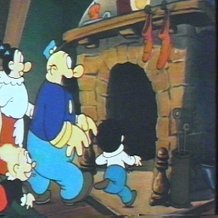
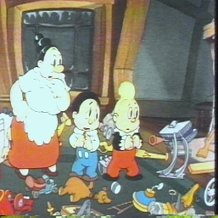
MUSICAL THEATRE PRODUCTIONS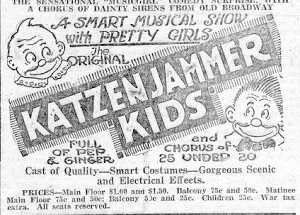
The popularity of the Katzies was such that it also spawned a musical theatrical production. I have only minimal information on this but, apparently, there were a number of similar productions or revivals over a period of 10 years or so. The image here is from a 1920 newspaper ad for this show. At least two large and colorful posters relating to this show are known to exist as well as a booklet of sheet music. BOOKS & MERCHANDISE 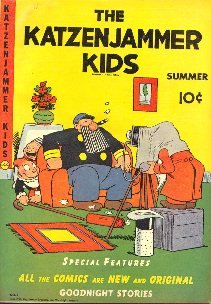
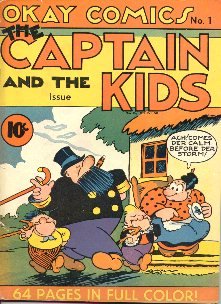 The competition between two versions of this popular comic strip extended into spin-offs of the characters. Just as there were two competing comic "strips," there were also two comic "book" versions. Seen here is issue #1 of Katzenjammer Kids comics, along with issue #1 of Okay Comics featuring The Captain and the Kids. The separate sets of characters appeared in several different titled comic books over the years. Some of them consisted of reprints of the Sunday pages. Others contained original stories and art. The latter were drawn by artists other than Dirks and Knerr. Foreign editions of both versions were also produced. A selection of other comic book covers will found on a separate page. 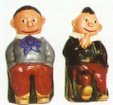
This set of Hans and Fritz banks was offered for sale by an antique toys dealer in 1996 for the handsome sum of $900. Your humble host was not among those who called to inquire about their availability. 
Seen here is the box cover for a set of four jigsaw puzzles. The picture on each of the four puzzles (including the one shown on the cover) is a slight variation of a panel from a Sunday comic strip page by Knerr. The Sunday comic strips were commonly edited and altered to make them fit in such things as children's books, comic book reprints, and foreign language versions. 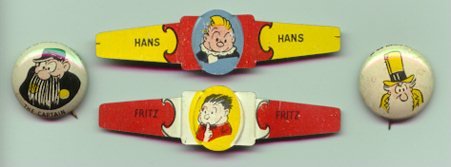 Cereal box giveaways were all the rage in the 1940's. Kellogg's "Pep" offered a series of more than 80 comic character pin-back buttons. Imagine how much cereal you would have to eat in order to get them all! Here we see the Captain and the Inspector on such buttons from 1946. Not to be outdone, Post's "Toasties" Corn Flakes offered a set of comic character metal bend-around-your-finger rings. Here we have Hans and Fritz on such rings from 1949. IMITATIONS and PARODIES The incredible popularity of the Katzenjammer Kids comic strip at its height is hard to fully appreciate from our vantage point. In the days before radio, television, computers, theme parks, and video games, mass popular entertainment was a new concept. There were several imitators, even straight out copies, of the Katzenjammer Kids being peddled by rival newspaper syndicates. The best of these, The Fineheimer Twins, is covered in my H.H. Knerr page. 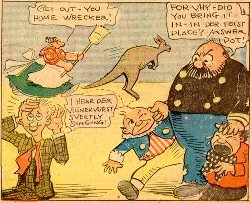
Perhaps the most blatant of the imitations (and certainly among the most poorly rendered) was a strip entitled Dem Boys by an artist known only as "Karls." The panel shown here is from the December 27, 1914, strip as it appeared in the Cleveland Sunday Dealer. Something tells me that if someone were to pull a stunt like this today, he would be slapped with a lawsuit and shut down in short order. 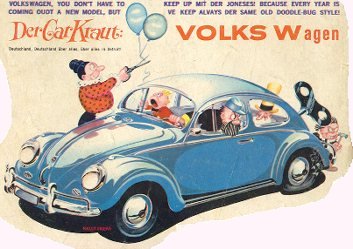
Popular characters also inspire parodies. The Katzenjammer Kids have been the subject of satire and lampoons in everything from the "Tijuana Bible" 8-pagers to "National Lampoon." A nice example, presented as an ad for Volkswagen, appeared on the back cover of "Mad" magazine #52, way back in 1959. A portion of that phoney advertisement is shown here. 
One of the more outrageous parodies (at least among those that can be presented on a "family" home page) is found in "National Lampoon presents The Very Large Book of Comical Funnies," published in 1975. Here are the first three panels of a 12-panel page in which "The Katzperjammers Kids" trick the authorities into thinking that Mama and the Captain are Jewish. Seek this one out if you enjoy being offended in the time-honored National Lampoon manner. ODDS and ENDS 
In the first decade of the 20th Century, Rudolph Dirks produced drawings for a number of Katzenjammer Kids postcards that were given away as promotional items by newspapers. Some of these contained a special image that could be seen only by heating the card with an iron. One of the nicer postcard images is found on a special holiday season card from 1906. You may click the little image for a larger view. 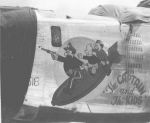
Among the most unusual appearances by the Katzies was in the form of "airplane nose art." Seen here in the "Captain and the Kids" version, this image was lifted from the remarkable Airplane Nose Art web site. The "kids" have also appeared on note pad covers, coloring books, and Christmas tree lamp bulbs, even as a pattern on children's pajamas. Perhaps someone will throw them on the scanner and bring a picture to this page at some point in the future. ORIGINAL ART Only a small portion of the "original" art for the Katzenjammer Kids comic strips has survived. Years ago, these original drawings were not regarded as having any collectible value and they were routinely discarded after being used to prepare the Sunday comic section printing plate. A small number are still in existence, primarily those which were given away to fans who wrote to the artist or syndicate to request them. It is a little known fact that the original drawings were all in black and white. The color was added during the printing process, often according to a set of instructions prepared by the artist. Today these originals are sold at auction or by specialty dealers for hundreds of dollars a piece. In addition to the original Sunday page art, an artist would occasionally do a "specialty" drawing at the request of a fan or, perhaps, for a special occasion. Additional information about Katzenjammer Kids originals, an example of a special inscription, and a discussion of the value thereof, may be found at the bottom of my H.H. Knerr page. Or, if you wish, you may go directly to the original art page. Needless to say, if you have a Katzenjammer Kids original, I would be interested in purchasing it.
Still looking for the full-page Sunday comic pages that you hoped to find at this site? Two of them can be accessed from the Katzenjammer Kids section of the H.H. Knerr page. 
There you have it, an Internet introduction to the fabulous Katzenjammer Kids. May they never be forgotten. I welcome your feedback, contributions, remarks, and offers to sell (or to give away for that matter) Katzenjammer-related collectibles. I am often asked "Where can I find a Katzenjammer Kids comic book?" or other rare collectible. The answer is -- the eBay auctions! Click the eBay icon and become a registered member today. Yes, it's free, but please don't bid against "Otto." Hey folks, that's me! |
|
Just click one of these icons and bookmark or make a favorite of the page it takes you to. Thereafter, your purchases from Amazon will produce a small credit to yours truly. The eBay icon takes you to a list of items that my alter ego, Otto, is offering at auction this week. Donations Are Welcome If you are one of those rare angels who would like to make a modest donation to support my efforts, you may do so by clicking the Pay Pal "Donate" image and filling in the pertinent information that will appear on the next screen. It's fast and easy and your surprising generosity will be greatly appreciated. MORE? Many other areas of the "Popular Culture Excavation Site" await you. Full descriptions are on the main menu or go directly to the area of your choice by clicking one of these seductive little images.Go to the H.H. Knerr
Katzenjammer Kids page.
This page created and maintained by Vebmeister Jim Lowe First appearance: May 18, 1997 Last updated: June 25, 1998 |
© 1997 by James R. Lowe, who reserves all rights to the content of this page not successfully claimed by others. Speaking of which, King Features Syndicate could very well have something to say about that. Indeed, they actually did. I appreciate their gracious permission to continue displaying these characters for your enjoyment. "Katzenjammer Kids" is a registered trademark of The Hearst Corporation and is used by permission.